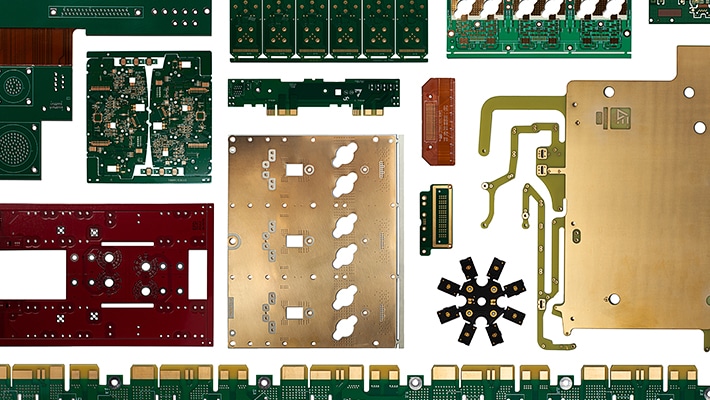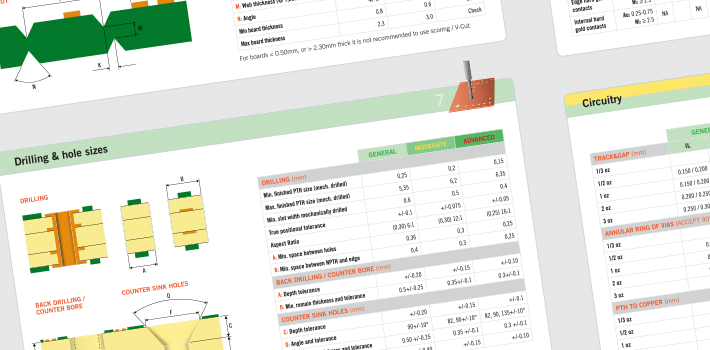PCB etchback is a process applied within to maintain optimized routing signals between multiple layers within printed circuit boards. Specifically, etchback supports plated through holes (PTH) processes, where manufacturers add electroless copper plating to the inner walls of the via hole. PTH improves conductivity by connecting the printed circuits in multilayer PCBs.

Understanding Etchback Processes
Essentially, PCB etchback involves the removal of epoxy resin from the sides of a drilled via hole. (i.e., electroplated for conductivity) to preserve maximized electrical conductivity between layers.
Etchback processes are requirements in some high-reliability applications. The IPC-6013 standards state that etchback should expose at least 0.003 mm (0.001”) and a maximum of 0.08 mm (0.003”) of copper when referenced in the product procurement documentation.
Micro-etch processes improve via plating adhesion by submerging or spraying a base laminate and drilling through-holes into the multilayer PCB. Manufacturers then apply a plasma etch that removes the excess smears and dielectric debris from the plated sidewalls in a process called de-smearing.
Additionally, manufacturers couple de-smearing processes with PCB etchback that etches into a plated via hole or lengthens copper layers, further improving the electrical connectivity of the PCB product. Etchback enables manufacturers to plate three sides of the copper layer and enhances PCB design sustainability.
Causes of Epoxy Resin Smears
Dielectric resin smears occur during the drilling process when drill temperatures exceed a substrate’s glass transition temperature, melting the resin and spreading it across the inner layer copper surfaces. The melted portions of the resin may obstruct the terminal of inner layers, reducing the efficiency of electrical conductivity.
Type of PCB Etchback
There are two main types of PCB etchback, negative and positive, each with different appearances and results.
Negative PCB Etchback
Negative PCB etchback features inner copper layers receding from the edge of the hole walls (i.e., thorough-hole barrel), with varying degrees according to the circuit board’s configurations.
A negative etchback takes on a less aggressive approach compared to positive etchback processes and works best in the manufacturing of high-reliability and long-term applications.
Negative etchbacks do not contain stress points in the internal plane, creating smooth copper barrel sidewalls . On the downside, when used in excess, these processes may form layer separations caused by contamination and air pockets.
Positive PCB Etchback
Alternatively, a positive PCB etchback displays a copper land protruded from the crossed edge of the hole walls, providing a solid three-terminal contact. Manufacturers often apply positive etchback in high-reliability multilayer PCB in the medical, aerospace, and military fields.
Manufacturers apply positive etchback in the aggressive smear removal of dielectric material. One major disadvantage of positive etchback is the possible formation of through-hole barrels and foil cracks due to the stress buildup on the fabric. However, this option is available at a premium.
PCB Etchback Techniques
Manufacturers may choose from a range of PCB etchback techniques that apply various solutions, with differing results according to environmental conditions. PCB manufacturers may apply chemical or plasma etch techniques.
Chemical Etch
Chemical processes often involve an alkaline potassium permanganate etchant. In most instances, manufacturers remove the etchant before plating a via. Manufacturers may apply concentrated sulphuric acidthat eliminates water from the air, resulting in a limited time span, which results in varying resin removal rates according to purity.
Alternatively, manufacturers may apply chromic acid, which provides a uniform removal rate for resins. However, the process comes at the risk of water pollution.
Plasma Etch
Plasma is a costly PCB etchback technique that enables quick and easy stain removal, which significantly improves via reliability. Plasma-based solutions function by creating gaseous-free radicals that erode the epoxy resin buildup, forming charged gases that manufacturers eliminate at the end of the process. Reduced manufacturing throughput and time of processing adds to the total cost of the PCB. And after plasma etchback you are still looking for a pass through the chemical desmear process to obtain a glass etch and remove the loose glass fibers.
Closing Thoughts
Some manufacturers may use the term “etchback” and “de-smearing” interchangeably. However, there are some slight differences between the manufacturing processes. Essentially, manufacturers may choose to conduct de-smearing processes without the need for resin etchbacks.
Smear removal/ de-smearing removes resins from the hole wall to create adequate inner layer electrical conductivity. Etchback improves the conductivity made from the de-smearing process by lengthening or etching copper layers. From a practical perspective, etchback works well in multilayer PCB while ineffective for double-sided printed circuit configurations.
Additionally, chemical etchback methods are more affordable than plasma alternatives. However, they are generally less efficient and contain caustic ingredients that might prove hazardous during handling. Alternatively, plasma etchback treatments provide manufacturers with acceptable accuracy, enabling improved customization and tailoring of drilling processes.
Plasma processes serve as safe and eco-friendly alternatives, comprising bi-products that manufacturers can dispose of without accumulating hazardous waste. Partnering with a specialized PCB etchback expert enables manufacturers to achieve higher adaptability, optimized repeatability, and precision for the most complex manufacturing processes. This all contributes to a more sustainable PCB — the reliability of the board reduces possible waste and harsh chemicals to the environment, while improving reliability. Although this process comes at a premium, you can be surer there won’t be any additional time needed to rebuild boards, resulting in the lowest total cost.

PCB design tools
For more advice about PCB design or applications of PCBs, we
have different PCB tools that can be downloaded for free.
